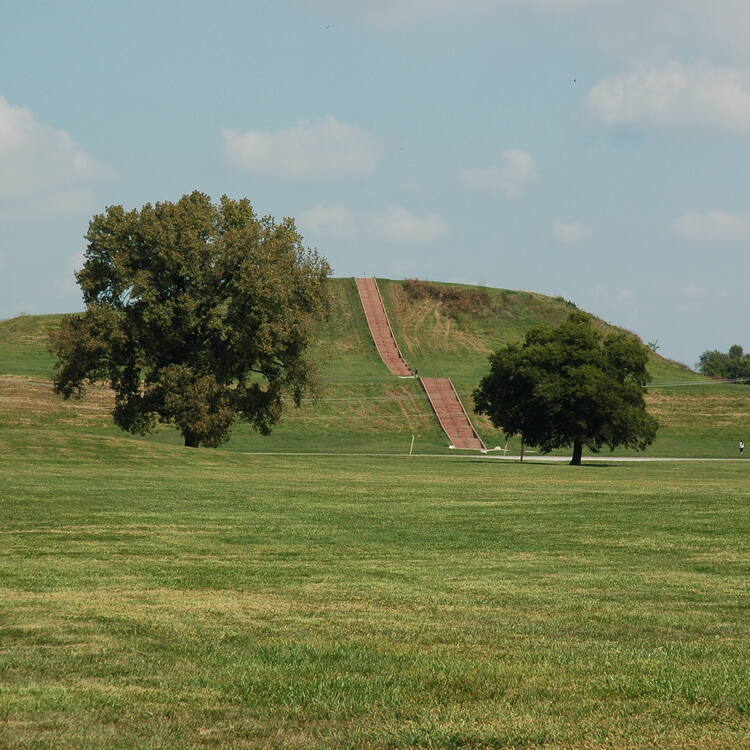Cahokia Mounds State Historic Site
Cahokia Mounds State Historic Site
Cahokia Mounds, some 13 km north-east of St Louis, Missouri, is the largest pre-Columbian settlement north of Mexico. It was occupied primarily during the Mississippian period (800–1400), when it covered nearly 1,600 ha and included some 120 mounds. It is a striking example of a complex chiefdom society, with many satellite mound centres and numerous outlying hamlets and villages. This agricultural society may have had a population of 10–20,000 at its peak between 1050 and 1150. Primary features at the site include Monks Mound, the largest prehistoric earthwork in the Americas, covering over 5 ha and standing 30 m high.
Description is available under license CC-BY-SA IGO 3.0
Site historique d'Etat des Cahokia Mounds
Le site des Cahokia Mounds, à environ 13 km au nord de Saint Louis, Missouri, représente le plus grand foyer de peuplement précolombien au nord du Mexique. Il a été occupé essentiellement pendant le mississippien (800-1400), période où il couvrait 1 600 ha et comptait quelque 120 tumulus. C'est un remarquable exemple de société complexe fondée sur la chefferie et comprenant beaucoup de tumulus satellites et de nombreux hameaux et villages excentrés. Cette société agricole pourrait avoir atteint une population de 10 000 à 20 000 habitants à son apogée entre 1050 et 1150. Parmi les lieux essentiels du site, il faut noter Monks Mound, le plus grand ouvrage préhistorique en terre des Amériques, qui couvre plus de 5 ha et fait 3 m de haut.
Description is available under license CC-BY-SA IGO 3.0
الموقع التاريخي لولاية الكاهوكيا ماوندز
يمثل موقع كاهوكا ماونذر الواقع عند 31 كيلومتراً شمال سانت لويس، ميسوري أكبر مواطن السكن في الحقبة ما قبل الكولومبيّة شمال المكسيك. أصبح موطن سكن في خلال حقبة الميسيسيبي (800-1400) عندما كان يغطي 1600 هكتار ويضمّ حوالى120 حجراً. هو مثال استثنائي عن مجتمع معقّد تأسس على مبدأ المقاطعات ويضمّ العديد من الهضاب المجاورة والقرى البعيدة عن المركز. لعلّ عدد سكّان هذا المجتمع الزراعي بلغ 10000 إلى20000 بين عامي1050 و1150. ومن بين أبرز محطات الموقع حجارة مونكس ماوند وهي تحفة العصر الحجري الأعظم في الأراضي الأمريكيّة والتي تغطي أكثر من 5 هكتارات وتعلو على ارتفاع ثلاثة أمتار.
source: UNESCO/CPE
Description is available under license CC-BY-SA IGO 3.0
卡俄基亚土丘历史遗址
卡俄基亚土丘历史遗址位于密苏里州圣路易斯城东北部约13公里处,这是哥伦布发现美洲前墨西哥以北地区最大的聚居地。该遗址主要在密西西比纪(公元800年至1400年)时期开始有人类居住,占地1600公顷,包括120个土丘。该遗址是古代部落社会的典型样例,以类似中心城和卫星城的模式进行规划,在中心城市周围有许多小村庄。这个农业社会在其鼎盛时期(约公元1050年至1150年间)约有人口1万至2万。在这个遗址上我们还可以找到一些远古建筑,例如当地的寺庙丘,这是美洲大陆上最大的史前土木工程,占地超过5公顷,高约30米。
source: UNESCO/CPE
Description is available under license CC-BY-SA IGO 3.0
Исторический памятник Курганы Кахокии
Курганы Кахокии, находящиеся приблизительно в 13 км к северу-востоку от Сент-Луиса (штат Миссури), – это крупнейшее доколумбово поселение из всех, располагающихся севернее Мексики. Оно было обитаемо в основном в течение «периода Миссисипи» (800-1400 гг.), когда занимало порядка 1,6 тыс. га и включало около 120 курганов. Это яркий пример древнего племенного поселения, которое включает многочисленные связанные с ним курганы и окрестные небольшие поселки. Данное аграрное сообщество на пике своего развития в 1050-1150 гг. могло иметь население порядка 10-20 тыс. человек. Среди главных достопримечательностей – «Монашеский курган», крупнейшее доисторическое земляное сооружение в Америке, имеющее площадь 5 га и высоту 30 м.
source: UNESCO/CPE
Description is available under license CC-BY-SA IGO 3.0
Sitio histórico estatal de Cahokia Mounds
Ubicado a unos 13 kilómetros al norte de San Luis (Misuri), el sitio de Cahokia Mounds es el mayor asentamiento humano precolombino encontrado al norte de México. Este lugar fue habitado en el Período Misisipiano (800-1400 d.C.), época en la que se extendía por unas 1.600 hectáreas y contaba con unos 120 túmulos. Los vestigios del sitio muestran la existencia de una sociedad compleja gobernada por caciques, así como la presencia de numerosos túmulos satélites y aldeas y pueblos periféricos. Esta sociedad agrícola llegó a tener probablemente unos 10.000 a 20.000 habitantes en el momento de su apogeo (1050-1150 d.C.). Otro elemento importante de este sitio es Monks Mound, el mayor túmulo prehistórico de las Américas, que tiene cinco hectáreas de superficie y treinta metros de altura.
source: UNESCO/CPE
Description is available under license CC-BY-SA IGO 3.0
カホキア墳丘群州立史跡
source: NFUAJ
Historische plaats Cahokia Mounds
Source: unesco.nl
Outstanding Universal Value
Brief synthesis
Located in Collinsville, Illinois near the city of St. Louis, this largest pre-Columbian settlement north of Mexico is the pre-eminent example of a cultural, religious, and economic centre of the Mississippian culture (800–1350), which extended throughout the Mississippi Valley and the south-eastern United States. This agricultural society may have had a population of 10,000–20,000 at its peak between 1050 and 1150, which was equivalent to the population of many European cities at that time. It once covered more than 1,600 hectares and included some 120 mounds.
Cahokia Mounds State Historic Site includes 51 platform, ridgetop, and conical mounds; residential, public, and specialized activity areas; and a section of reconstructed palisade, all of which together defined the limits and internal symmetry of the settlement. Dominating the community was Monks Mound, the largest prehistoric earthen structure in the New World. Constructed in fourteen stages, it covers six hectares and rises in four terraces to a height of 30 meters. The mounds served variously as construction foundations for public buildings and as funerary tumuli. There was also an astronomical observatory (“Woodhenge”), consisting of a circle of wooden posts. Extensive professional excavations have produced evidence of construction methods and the social activities of which the structures are further testimony.
Criterion (iii): Dating from the Mississippian period (800–1350 at this site), Cahokia Mounds is the largest pre-Columbian archaeological site north of Mexico; it is also the earliest of the large Mississippian settlements. It is the pre-eminent example of a cultural, religious, and economic center of the prehistoric Mississippian cultural tradition.
Criterion (iv): Cahokia graphically demonstrates the existence of a pre-urban society in which a powerful political and economic hierarchy was responsible for the organization of labor, communal agriculture, and trade. This is reflected in the size and layout of the settlement and the nature and structure of the public and private buildings.
Integrity
Within the boundaries of the property are located the main elements necessary to understand and express the Outstanding Universal Value of Cahokia Mounds State Historic Site, including the central mounds, the palisade, most of the “Woodhenge” and the functional areas. All three types of mounds are preserved, as well as borrow pits. The course of the palisade remains almost completely intact. Large areas adjacent to the core of the site have been acquired, reclaimed from development, and restored to preserve the historic setting. The property is thus of sufficient size to adequately ensure the complete representation of the features and processes that convey the property’s significance, and it does not suffer from adverse effects of development and/or neglect. Although there is no official buffer zone, designation by the federal government of a larger area as a National Historic Landmark (1964), now containing additional State-owned property, provides equivalent protection.
Authenticity
Cahokia Mounds State Historic Site is authentic in terms of its forms and designs, materials and substance, and location and setting. Although some mounds have been damaged by past cultivation or development, many are merely truncated, and the mound bases remain. Contemporary structures, such as the interpretive centre, have been erected on concrete slabs so as not to disturb the underlying archaeological resources. A major highway and railroad traverse the site, but both are minimally visible. The highway is built in the Cahokia Creek floodplain where it does not greatly affect major subsurface archaeological features, and the railroad is built on an embankment.
Known and potential threats to the property include erosion due to both natural and human causes, development, flooding (and flood control actions), and damage to subsurface archaeological features from deep-rooted plant species.
Protection and management requirements
The property is owned by the State of Illinois and designated by Illinois law as a State Historic Site specifically for its preservation and public interpretation. The core of the State Historic Site has been preserved as a protected public site since 1925. Its archaeological resources are further protected by State law and regulation. The Illinois Historic Preservation Agency, an agency of the State of Illinois, manages the entire property. The updated Master Management Plan (2008) addresses the protection, preservation, interpretation, restoration, and research of the State Historic Site and the State provides professional staff to manage and interpret it for the public. A staffed interpretive centre opened in 1989.
The Master Management Plan and a monitoring program are part of a long-term strategy for the property to aid in addressing known and potential vulnerabilities such as erosion, development, flooding (and flood control), and damage to subsurface archaeological features from deep-rooted plant species.


